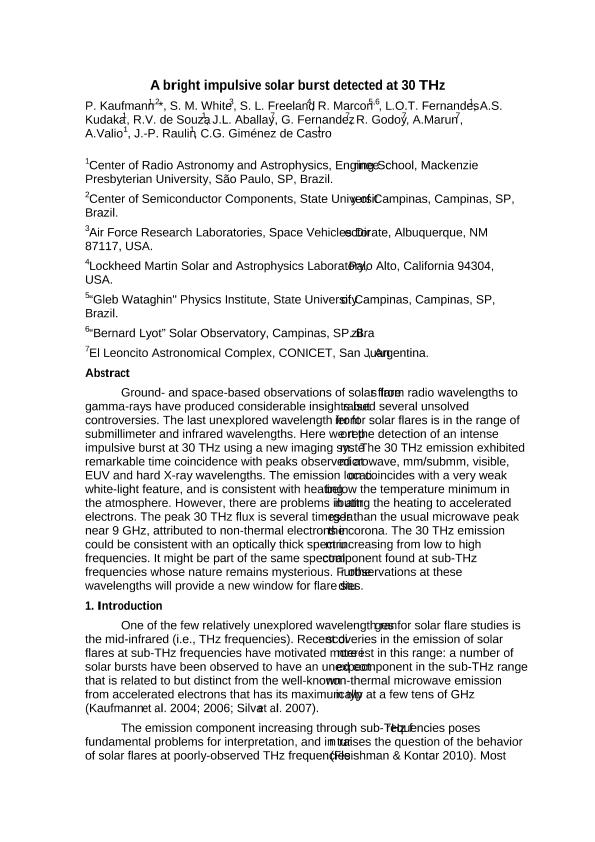Mostrar el registro sencillo del ítem
dc.contributor.author
Kaufmann, P.
dc.contributor.author
White, S. M.
dc.contributor.author
Freeland, S. L.
dc.contributor.author
Marcon, R.
dc.contributor.author
Fernandes, L. O. T
dc.contributor.author
Kudaka, A. S.
dc.contributor.author
de Souza, R. V.
dc.contributor.author
Aballay, Jose Luis

dc.contributor.author
Fernandez, German Enzo Leonel

dc.contributor.author
Godoy, Rodolfo Alfredo

dc.contributor.author
Marun, Adolfo Hector

dc.contributor.author
Valio, A.
dc.contributor.author
Raulin, J. P.
dc.contributor.author
Gimenez de Castro, Carlos Guillermo
dc.date.available
2015-08-12T13:09:18Z
dc.date.issued
2013-04-23
dc.identifier.citation
Kaufmann, P.; White, S. M.; Freeland, S. L.; Marcon, R.; Fernandes, L. O. T; et al.; A Bright Impulsive Solar Burst Detected at 30 Thz; IOP Publishing; Astrophysical Journal; 768; 2; 23-4-2013; 1-9
dc.identifier.issn
0004-637X
dc.identifier.uri
http://hdl.handle.net/11336/1634
dc.description.abstract
Ground- and space-based observations of solar flares from radio wavelengths to gamma-rays have produced considerable insights but raised several unsolved controversies. The last unexplored wavelength frontier for solar flares is in the range of submillimeter and infrared wavelengths. Here we report the detection of an intense impulsive burst at 30 THz using a new imaging system. The 30 THz emission exhibited remarkable time coincidence with peaks observed at microwave, mm/submm, visible, EUV, and hard X-ray wavelengths. The emission location coincides with a very weak white-light feature, and is consistent with heating below the temperature minimum in the atmosphere. However, there are problems in attributing the heating to accelerated electrons. The peak 30 THz flux is several times larger than the usual microwave peak near 9 GHz, attributed to non-thermal electrons in the corona. The 30 THz emission could be consistent with an optically thick spectrum increasing from low to high frequencies. It might be part of the same spectral component found at sub-THz frequencies whose nature remains mysterious. Further observations at these wavelengths will provide a new window for flare studies.
dc.format
application/pdf
dc.language.iso
eng
dc.publisher
IOP Publishing

dc.rights
info:eu-repo/semantics/openAccess
dc.rights.uri
https://creativecommons.org/licenses/by-nc-sa/2.5/ar/
dc.subject
SUN: ACTIVITY
dc.subject
SUN: FLARES
dc.subject
SUN: INFRARED
dc.subject
SUN: RADIO RADIATION
dc.subject
SUN: UV RADIATION
dc.subject
SUN: X-RAYS, GAMMA RAYS
dc.subject.classification
Astronomía

dc.subject.classification
Ciencias Físicas

dc.subject.classification
CIENCIAS NATURALES Y EXACTAS

dc.title
A Bright Impulsive Solar Burst Detected at 30 Thz
dc.type
info:eu-repo/semantics/article
dc.type
info:ar-repo/semantics/artículo
dc.type
info:eu-repo/semantics/publishedVersion
dc.date.updated
2016-03-30 10:35:44.97925-03
dc.journal.volume
768
dc.journal.number
2
dc.journal.pagination
1-9
dc.journal.pais
Reino Unido

dc.journal.ciudad
Londres
dc.conicet.avisoEditorial
This article contains IOP information made available under a CC BY 3.0 licence
dc.description.fil
Fil: Kaufmann, P.. Universidade Presbiteriana Mackenzie. Escola de Engenharia. Centro de Radio Astronomia e Astrofisica; Brasil; . Universidade Estadual de Campinas; Brasil
dc.description.fil
Fil: White, S. M.. Space Vehicles Directorate. Air Force Research Laboratories; Estados Unidos
dc.description.fil
Fil: Freeland, S. L.. Lockheed Martin Solar and Astrophysics Laboratory; Estados Unidos
dc.description.fil
Fil: Marcon, R.. Universidade Estadual de Campinas; Brasil
dc.description.fil
Fil: Fernandes, L. O. T. Universidade Presbiteriana Mackenzie. Escola de Engenharia. Centro de Radio Astronomia e Astrofisica; Brasil;
dc.description.fil
Fil: Kudaka, A. S.. Universidade Presbiteriana Mackenzie. Escola de Engenharia. Centro de Radio Astronomia e Astrofisica; Brasil;
dc.description.fil
Fil: de Souza, R. V.. Universidade Presbiteriana Mackenzie. Escola de Engenharia. Centro de Radio Astronomia e Astrofisica; Brasil;
dc.description.fil
Fil: Aballay, Jose Luis. Consejo Nacional de Investigaciones Científicas y Técnicas. Centro Científico Tecnológico - CONICET - San Juan. Complejo Astronómico; Argentina
dc.description.fil
Fil: Fernandez, German Enzo Leonel. Consejo Nacional de Investigaciones Científicas y Técnicas. Centro Científico Tecnológico - CONICET - San Juan. Complejo Astronómico; Argentina
dc.description.fil
Fil: Godoy, Rodolfo Alfredo. Consejo Nacional de Investigaciones Científicas y Técnicas. Centro Científico Tecnológico - CONICET - San Juan. Complejo Astronómico; Argentina
dc.description.fil
Fil: Marun, Adolfo Hector. Consejo Nacional de Investigaciones Científicas y Técnicas. Centro Científico Tecnológico - CONICET - San Juan. Complejo Astronómico; Argentina
dc.description.fil
Fil: Valio, A.. Universidade Presbiteriana Mackenzie. Escola de Engenharia. Centro de Radio Astronomia e Astrofisica; Brasil;
dc.description.fil
Fil: Raulin, J. P.. Universidade Presbiteriana Mackenzie. Escola de Engenharia. Centro de Radio Astronomia e Astrofisica; Brasil;
dc.description.fil
Fil: Gimenez de Castro, Carlos Guillermo. Universidade Presbiteriana Mackenzie. Escola de Engenharia. Centro de Radio Astronomia e Astrofisica; Brasil;
dc.journal.title
Astrophysical Journal

dc.relation.alternativeid
info:eu-repo/semantics/altIdentifier/url/http://arxiv.org/abs/1303.5894
dc.relation.alternativeid
info:eu-repo/semantics/altIdentifier/doi/http://dx.doi.org/doi:10.1088/0004-637X/768/2/134
dc.relation.alternativeid
info:eu-repo/semantics/altIdentifier/url/http://iopscience.iop.org/0004-637X/768/2/134/pdf/0004-637X_768_2_134.pdf
Archivos asociados
